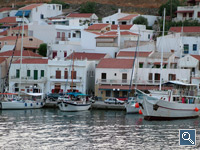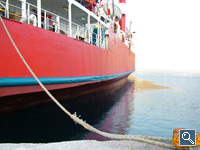| Kea Island |
According to Greek Mythology, the island’s name came from Keo, the son of Apollo and leader of the Locrians. Based on archaeological findings, the island of Kea (Tzia) has been inhabited since the Post-Neolithic Period and was a great cultural center during the Bronze Age. Kea (Tzia) participated in the Persian Wars and was part of the Athenian Alliance. During the Byzantine Era, Kea (Tzia) belonged to the Eastern Roman Empire and then was occupied by the Turks from 1566 till 1821 when it was finally liberated, greatly due to the efforts of the national hero Lambros Katsonis. Upon its liberation from the Ottoman Empire, Kea (Tzia) flourished in the field of industry (enamel, metal, wood). Recently, Kea (Tzia) has developed into one of Greece’s up and coming vacation destinations. Kea (Tzia) Sites and Attractions In the capital Hora (Ioulida)
In Korissia
In Vourkari
Other interesting sites on Kea (Tzia) are the splendid Ancient Site in Karthea, the Panagia Kastrianis Monastery in Otzias, the Poessa Fort in Pisses and the view from the Profitis Ilias Chapel. Kea (Tzia) Beaches On Kea (Tzia) Island there is an abundance of beautiful beaches to choose from. Some are small bays and others are long stretches of sand. Most beaches have restaurants and cafés either on the beachfront or close by. Several also possess water sport facilities for the adventurous visitors. The most popular beach is Gialiskari, which has golden sands, azure waters and is lined with tamarisk trees. A few kilometers south, is Korissia Beach, with fine sands and calm waters. In the middle of the western side of Kea (Tzia) are Xyla Bay, a beach with soft sands and crystal-clear waters, the long sandy beaches of Pisses and Koundouros, a series of small bays with fine sands and clean waters. On the western side of Kea (Tzia) are some of the finest beaches on the island: Orkos, Sykamia, Psili Ammos, Kalidonychi and Spathi. They are located close to each other and are famous for their beautiful sands. In the north of Kea (Tzia) is Otzias, the longest beach on the island. It is a sheltered bay area, with tamarisk trees offering shade from the sun. Nearby Islands From Kea (Tzia) Island, we suggest taking a day trip to the historical island of Makronissos, located northwest of Kea (Tzia). It is believed to be one of Helen of Troy’s stops either on her way to Troy or on her way back home. Local Cuisine of Kea (Tzia) Island Kea (Tzia) offers its visitors a wide variety of mouth-watering traditional delicacies that are served at the tavernas and restaurants in the island’s seaside and mountain villages. For seafood lovers, there are mussels and rice, lobster pasta and sea urchin salad. If you prefer meat dishes, we suggest you try “paspalas” (pork with eggs and tomato) and “loza” (salted pork). Some hors d’ oeuvre style dishes are mushroom pie, tomato balls and squash balls. Lastly, do not forget to try the famous locally produced “mavro” wine. Kea Nightlife & Festivities of Kea (Tzia) Island Although Kea (Tzia) is a relatively quiet island, it does offer a broad range of tavernas, restaurants, cafés, bars and clubs in Hora (Ioulida), the capital of the island, as well as along the port of Korissia and in the settlement of Voukari. In Hora (Ioulida) the capital of Kea (Tzia), various traditional festivals are held during the summer. We suggest you attend the festival of Agia Marina on the 17 th of July and the festival of the Panagia of Kastrianis on the 15 th of August. During August, the “Simonidia” Festival take place, which is a cultural event that includes dance and theatrical performances, as well as art and sports exhibitions. In the other villages, festivals are also held, mainly on the name day of their church or patron saint. How to reach Kea (Tzia) Island Kea (Tzia) Island can be reached by boat from Lavrio Port ( Attica) . |
|
| Cyclades Islands | Tourism | United Hellas Home Page |
| Hotels - Apartments - Suites throughout Greece | Car Rentals throughout Greece |
| Travel Agencies throughout Greece | Cruises & Sailing Yacht Charters in Greece |

